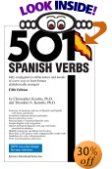|
Not exactly riveting reading but this best-seller 501 Spanish Verbs is a must on the shelf...Chris Kendris's 501 Spanish Verbs has not hit the giddy heights of sales without good reason. For many years it has become the 'must-have' for the Spanish language student, new or advanced, and for the Spanish teacher or tutor. Want to learn Spanish, then you need this book.
But do not expect an easy read. It is written by an academic, for academic students, and unless you enjoy reading dictionaries for leisure it is heavy going. But ... having said that, it is a very good reference book on Spanish verbs. Read below the summary of the promotional blurbs on the book, then below that I'll tell you some of the drawbacks. This is the Lingwhizz'd's choice for most essential Spanish verb book. 501 Spanish Verbsby Chris Kendris PhD. Here are the good bits. 
The Drawbacks of 501 Spanish Verbs The thing that annoys me when using this book is that it is written by an academic for academics, (like most things written by academics). Whether they intend to or not, most academics are very difficult for an ordinary person to understand. What I mean by this is that it is very clumsy and cumbersome and difficult to use. For example here are the 14 headings under which Dr Kendricks conjugates the 501 Spanish Verbs. The Tenses in 501 Spanish VerbsThe Seven Simple Spanish Verbs Tenses are:
The Seven Compound Spanish Verbs Tenses are:
The Drawbacks of 501 Spanish VerbsProfessor Kendricks lays out the above Spanish Tenses in the introductory chapters of 501 Spanish Verbs, and then explains each one is some considerable detail. And make no bones about, learning Spanish verbs is MORE DIFFICULT than learning English verbs. (English really gets the Hispanics back when it comes to Grammar, however . . .). When it comes however to listing each Spanish verb and its conjugations, one verb per page, with its approximately 100 conjugations PER SPANISH VERB, he very lists them under their Spanish verb names as follows. (Don't leave it here, because I am building to something.........) The Seven Simple Spanish Verbs Tenses are:
Well, that is all just great if you know what all those terms mean, but if you are buying a book to help you learn the Spanish verbs there's a very good chance that you don't! The English ones might as well be written in hieroglyphics for a huge number of users, who when looking up a word, have to keep going back to the front to find which of the 17 categories the word they are looking for fits. To improve his book's useability about four-fold, Dr Kendricks should have written in brackets in small fonts beside each Spanish conjugation title, an English example of a real live conjugate verb. Hopefully he will do so in his next edition. For example, beside his title:
You get the message. . . To make the book useable most new students need to print the definitions translated on a piece of paper like I have laid out above in brief. You also need a few post-it notes that you can stick to the pages to which you constantly refer, like some of the Spanish verbs like ir, ser, estar, haber, etc and such as the Spanish subject pronouns (I - yo; you (informal singular)- tú; he, she - él, ella - he, she; you (formal singular) - Usted; we - nosotros; you (informal plural) - vosotros, vosotras; they - ellos, ellas, Ustedes. The book is available from Amazon, Barnes and Noble and all major language book outlets and major bookstores. 501 Spanish Verbs. Chris Kendris PhD, Barron's Educational Series. Formerly Assistant Professor, Department of French & Spanish, State University of New York. For more books on Spanish VERBS click the link below: Looking for other Spanish information?Just type your keywords into the Google SiteSearch box, and it will take you to the pages you are looking for, on this site.Loads of stuff for the person learning Spanish language Learn Spanish Help. Copyright 2011. Transcity Properties Ltd, 32 Alverton, Great Linford, Milton Keynes, Bucks, MK14 5EF, United Kingdom |
 Custom Search |



